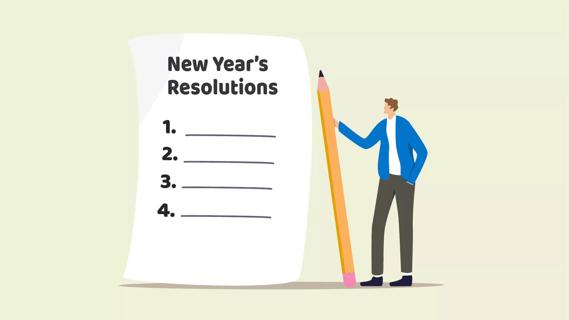It may feel impossible, but planning, motivation and goal-setting can make leaving old habits behind doable

There are times when you know you want to change — even when you know you need to change — but you find yourself resisting. What’s the deal? And what can you do about it?
Advertisement
Cleveland Clinic is a non-profit academic medical center. Advertising on our site helps support our mission. We do not endorse non-Cleveland Clinic products or services. Policy
With some planning, focus and perseverance, you can break bad habits, says registered psychotherapist Natacha Duke, MA, RP — and it’s worth it for all the potential benefits, like better self-esteem and improved longevity.
So, how can you break a habit, and how long will it take? Let’s dig in.
Oscar Wilde once wrote, “I can resist anything except temptation.” Bad habits are tempting by design — and there’s real psychology behind why we adopt them and why it’s so darn hard to break them.
“Bad habits can be hard to break due to the reward system in our brain,” Duke explains. “Even if something is ‘bad’ for us, it still gives us a surge of dopamine — the brain’s feel-good neurotransmitter, which only reinforces this behavior over time.”
Let’s say that your yoga studio is next door to a coffee shop. After class one day, you stop into the coffee shop and buy yourself a big, sugary frozen drink. The next time you take a yoga class, your brain says, “Hey, remember how tasty that was? Let’s do it again!” So, you get the same drink after class again.
Even if you don’t mean to do it, your brain has started to make the association between finishing yoga class and sipping on a sweet, sugar-laden beverage. Do it too many times in a row and you’ll have yourself a habit — one that can be really hard to break, despite your wanting to.
Advertisement
And low feelings can make bad habits feel that much worse.
“We’re also more likely to engage in ‘bad’ habits when we’re feeling stressed, lonely, sad, depressed or any other feeling that is difficult for us to tolerate,” Duke notes. “This is especially true if we don't possess other healthy coping strategies to manage and regulate our feelings.”
Whether you want to give up your frappe-after-yoga habit, quit smoking or banish some other habit that’s gnawing at you, there are steps you can take to make it happen. It won’t necessarily be easy — but it’ll be worth it!
Here are 11 ways to break bad habits.
When you’re trying to break a habit, one of the most important things to do is to prepare yourself to feel uncomfortable.
“As humans, we tend to avoid uncomfortable feelings,” Duke says. “When we’re trying to make a change, we often wait for willpower to kick in — but actually, it’s often our unwillingness to tolerate discomfort that keeps us from doing what we need to do.”
She suggests that you practice tolerating these feelings by making space for them and learning healthy ways to self-soothe.
Unfortunately, just thinking, “Hmm, I really should change,” isn’t usually enough to do the trick. (We wish!) Instead, whip out a piece of paper or a journal or open an app on your phone and start planning.
Get introspective. Consider the following:
You should also choose a start date — and no, it doesn’t have to be New Year’s Day! You can make resolutions any time, not just on January 1.
As part of your planning process, Duke encourages you to think about why you want to break this habit and what’s keeping you from it.
“We’re made of parts,” she says. “There’s often a part of us that wants to change and a part of us that doesn’t want to make a change, or that isn’t ready. It’s essential to make space for the latter part in order to mobilize your motivation to change.”
To do this, she says put pen to paper and list the reasons why you want to change. Just as importantly, make a list of all the reasons you don't want to change.
“If you don't acknowledge your ambivalence, it will be difficult to make true, lasting changes,” she says.
Advertisement
When you’re trying to make a change, it’s common to take on more than you can handle — to go really, really big right off the bat. But that’s often not the best move.
“Set expectations and goals that are moderately challenging, so you can set yourself up for success,” Duke suggests. “For most ‘bad’ habits, I recommend tapering down gradually and avoiding all-or-nothing thinking.”
Let’s say, for example, that you want to quit drinking soda. You swear you’re never, ever going to have another can, which means that as soon as you slip and pop that tab, you feel like a failure. This can lead you to abandon your goal entirely.
Instead, Duke advises adopting incremental goals that can help you achieve early success that you can build upon. If, for example, you typically drink two cans of soda each day, your initial goal might be to switch to two diet sodas each day. Once you achieved that goal, aspire to drink one diet soda a day, then one diet soda every other day — and so on, until you’ve hit your big goal.
“When you’re successful early on, you can use that feeling of success to increase your motivation and help you to keep making healthy choices,” she says. “But setting unrealistic goals or timeframes makes it less likely that you will be successful early on.”
Advertisement
You know you want to change, and you also know it’s not going to be easy. But what, exactly, keeps it from being easy? What has gotten in your way when you’ve tried to achieve this goal in the past? What has caused you to stumble or give up?
Maybe you’re most inclined to bite your nails when you’re under a super-stressful work deadline, or you tend to do all your mindless snacking when you’re zoned out in front of the TV. Maybe you never leave yourself enough time to get ready in the morning, so your bedroom ends up covered in discarded clothes with no time to clean up after yourself.
Once you know what might trip you up, you can better prepare yourself for it — so take the time to identify some of the challenges at the root of your habit, and then start thinking through what you can do when you’re faced with them again.
You don’t have to be like old Oscar Wilde! “Create a plan for what you’ll do when you feel triggered or tempted,” Duke says. “Having a plan that you write out in advance can help distract you from the unwanted behavior.” Some ideas include:
You can also try delaying the behavior. You know the phrase, “This too shall pass”? It can be true when you’re trying to break a habit, too.
Advertisement
“Delaying the behavior, even for 15 minutes, can lower the temptation,” Duke says.
In addition to distractions, you can build in some replacement behaviors — things you can do instead of your bad habit. For example:
One of the best ways to avoid temptation is to make sure temptation isn’t readily available to you at all.
If you’re trying to stop biting your nails, keep them trimmed so short that there’s nothing to bite. If you want to get rid of your sweet tooth, don’t keep sweets in your pantry or fridge. If you want to quit smoking, ask friends who smoke to please not do so around you.
Plus, depending on the habit you’re trying to break, keeping temptation away can mean saving money. By not purchasing sweets or cigarettes, you create a counter-incentive for yourself.
Speaking of, incentives can help you motivate yourself to do uncomfortable things.
“Consider starting an account with the money you would otherwise have spent on the bad habit and put it toward treating yourself to a special trip or something else that you really want,” Duke recommends.
You can identify something positive you’ll do for yourself once you hit your goals, or you can reward yourself along the way, like by throwing a dollar into a cookie jar every time you engage in a positive behavior.
“It’s also a great way to get back into a good habit if you stumble along the way,” she adds, “and makes it more likely you’ll continue in the right direction.”
Just make sure your incentives for breaking bad habits don’t encourage other bad habits. For example, if you’re trying to kick your food delivery habit, don’t reward yourself by eating frozen pizza every night instead!
When you beat yourself up, you feel ... well, beaten up. Negative self-talk can have negative effects on your mental health, self-esteem and motivation, so instead of talking down to yourself when you slip, try to be gentle and encouraging.
Think about the way you’d speak to a dear friend or even a small child who is trying to reach a goal. If they slipped up, you wouldn’t tell them, “You’re an idiot! You might as well give up!” You’d probably say something like, “Hey, it’s OK. You’re trying really hard, and you can get back on track right now. One slip-up doesn’t negate all the work you’ve done.” Do this for yourself, too.
Put a sticky note on your mirror. Create a new lock screen for your phone. Carry an index card in your wallet. Heck, mail yourself a card that you’ll receive a in few days!
However you do it, figure out ways to remind yourself of all the benefits of the changes you’re making — why it’s so important to you and what you’ll gain once you’ve achieved it.
If you’re having trouble breaking a habit, it might be time to talk to a healthcare provider, like a doctor or therapist. This is especially true if you’re dealing with something more than just a habit — like addiction or obsessive-compulsive disorder.
“If you’ve tried and tried but are still encountering roadblocks, reach out for support,” Duke encourages. “With smoking, for example, this is often helpful in creating a quitting plan and considering supports like nicotine replacement therapy or prescription medication.”
Cognitive behavioral therapy can also help you learn to challenge the thoughts that reinforce the behavior or make you more likely to throw in the towel after a slip-up.
You might’ve heard that it takes 21 days to break a bad habit (or start a new one). We hate to break it to you, but that’s an arbitrary timeline — and probably not an accurate one.
Experts believe it takes at least 10 weeks to break a bad habit, but it may take longer depending on what the habit is, how deeply ingrained it is and lots of other factors related to you as an individual. As with so much of life, there’s no one-size-fits-all answer.
Once you’ve finally broken a habit, what happens next? It’s time to adopt a maintenance schedule — in other words, planning to prevent a relapse.
“Bad habits are hard to break, and it usually takes more than one attempt to make a change,” Duke says. “Remember to practice being self-compassionate, which will make it more likely that you don’t give up after a setback.”
Learn more about our editorial process.
Advertisement

Pick specific, measurable goals, but also be open to changing them if need be

Focus on movement, nutrition and relaxation practices

It might simply come down to your personality

Like being your own best friend in times of trouble, self-love is an act of self-preservation

Foster communication about social media, encourage whole-person attributes and be mindful of your own negative self-talk

Like a boring ol’ grey rock, the goal is to be unresponsive and uninteresting to dissuade a harmful situation

Set yourself up for success by carefully choosing your recipes, storage containers and prepping day

People-pleasing, perfectionism and putting others first are all signs of this harmful behavior

Type 2 diabetes isn’t inevitable with these dietary changes

Applying a hot or cold compress can help with pain